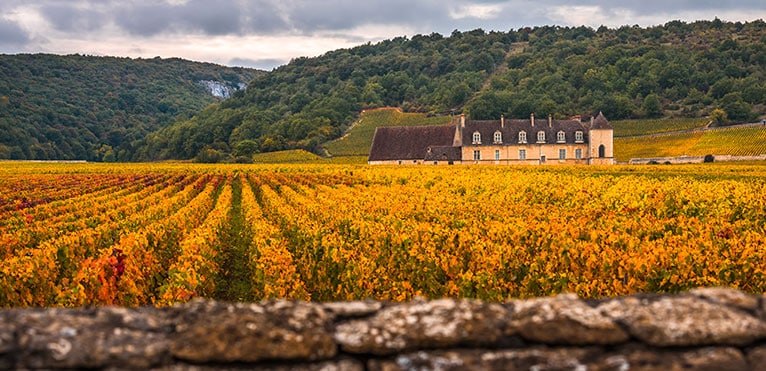
Contents
Chassagne Montrachet is an appellation located in Burgundy, in the Côte-d’Or and Saône-et-Loire departments. It is part of the Côte de Beaune vineyards, a sub-region of Burgundy producing red and white wines. It benefits from the French Appellation d’Origine Contrôlée label.
The history of Chassagne-Montrachet is linked to Christianity
The history of Burgundy’s vineyards dates back to antiquity, when Probus overturned Emperor Domitian’s decree prohibiting the cultivation of vines outside Italy. New vines were planted in the region. However, the rise of winegrowing Burgundy, and more specifically of the Chassagne-Montrachet vineyard, is linked to that of Christianity. Indeed, the mass ritual practiced by this religion increases the demand for mass wines for the faithful. Christianity also encouraged the establishment of abbeys in the region, to which the lords bequeathed their vines. From the 19th to the early 20th century, the vineyards suffered from various diseases that attacked the vines and limited wine production. This was boosted by new cultivation techniques and the labeling of the vineyard, which became an Appellation d’Origine Contrôlée in 1937. The quality of Chassagne-Montrachet wines is now widely recognized. This appellation comprises 55 climats classified as Premier Cru and produces 3 Grands Crus: Montrachet, Bâtard-Montrachet and Criots-Bâtard-Montrachet.
Chassagne-Montrachet produces wines recognized and admired the world over
The vineyards of Chassagne-Montrachet located to the south of the Côte de Beaune is home, along with Pulligny, to most of Burgundy’s great dry white wines. Its vineyards cover just over 300 hectares, 45% of which are reserved for the production of Premier Cru white wines.
The vineyard’s soils are clay-limestone, a composition that favors hydration of the vines and helps them fight rot. What’s more, the vines are grown on sloping ground where the soil is well drained. These characteristics enable optimal cultivation of the grape varieties essential to the production of the appellation’s white and red wines. In fact, white wines are made with Chardonnay and red wines with Pinot Noir, and these two grape varieties, although grown all over the world, offer their finest expression when cultivated on Burgundy’s exceptional limestone soils.
Chassagne-Montrachet offers full-bodied whites and generous reds
To the eye, Chassagne-Montrachet white wines are recognizable by their light gold color, tinged with green highlights. The bouquet is rich, with aromas of white flowers such as honeysuckle and verbena, and hints of hazelnut. These aromas are complemented by mineral and buttery notes, sometimes completed by hints of honey and ripe pear. The wines of this appellation are full-bodied with a lively attack. A few years of ageing will give these wines their smoothness. It is therefore advisable to enjoy them 3 to 12 years after bottling, so that they offer the palate an expression worthy of the regional know-how and the exceptional terroir from which they come.
Red wines have a bright red color with violet reflections tending towards black. On the nose, aromas of red fruits such as Morello cherry, raspberry, wild strawberry and redcurrant, complemented by animal and spicy notes. The palate is generous despite the austere tannins that can characterize these wines in their youth. With age, these wines become more complex, so it’s best to cellar them for between 5 and 15 years to allow them to reach their full potential.
Chassagne-Montrachet wines are best served with quality meat and fish.
The power and opulence of Chassagne-Montrachet white wines are a perfect match for white meats and fish. For example, they go wonderfully well with veal in sauce or wok-fried fish. What’s more, the appellation’s Premiers Crus are at their best when accompanied by refined dishes that match the wine they’re paired with, such as lobster or cooked foie gras. They should be enjoyed at a temperature of between 11 and 12 degrees.
The red wines are characterized by their power and beautiful tannic structure. In fact, they go very well with grilled meats such as grilled lamb, grilled pork or roast. They are also the perfect partner for poultry cooked with Indian spices such as tandoori or curry. Finally, their strength is a perfect match for cheeses such as chèvre or comté. To bring out their full expression, we recommend serving them at a temperature of between 14 and 16 degrees Celsius.
Know-how and tradition: remarkable family estates
Domaine Faiveley
This well-known Chassagne Montrachet estate was founded in 1825 by Pierre Faiveley, a local shoemaker with a passion for wine. In 1860, the estate was passed on to Joseph, his nephew, who chose to export the estate’s wines to the United States. Northern Europe. This trading activity strengthens the estate’s activities and raises its international profile. That’s why, seven generations later, Ève and Erwan Faiveley, the estate’s current owners, are now among Burgundy’s greatest proprietors. In fact, their vineyards cover 120 hectares, and the quality of their production is rewarded by wines classified as Grand Cru, such as their Batard-Montrachet.
Domaine Amiot Guy et Fils
Domaine Amiot Guy et Fils was founded in 1920 by Arsène Amiot. It was not originally run by Arsène Amiot, since a local winegrower was in charge of vinification and bottling. The Amiot family then ran the estate for 4 generations, handing it down from father to son. This 12-hectare estate cultivates prestigious vineyards such as Les Demoiselles in Pulligny. Its reputation is built on the quality of its wines, which are recognized in France and around the world, including a Grand Cru Classé like Montrachet.